Proteomic Profiling Reveals Novel Molecular Insights into Dysregulated Proteins in Established Cases of Rheumatoid Arthritis
Abstract
1. Introduction
2. Results
2.1. Clinical and Biochemical Data for the Study Participants
2.2. Proteomic Analysis and Identification of Differentially Expressed Proteins
2.3. Mass Spectrometry Analysis and Protein Identification Using MALDI-TOF
2.4. Orthogonal Partial Least Squares-Discriminant Analysis and Heat Map for the Proteomics Profile Between RA and Control Groups
2.5. Functional Enrichment of DAPs in RA Group Compared to Control Group
2.6. Biomarker and Network Pathway Analysis of the DAPs Using Bioinformatics
2.7. Multiple Reaction Monitoring (MRM) Mass Spectrometry
3. Discussion
3.1. Significantly Increased Proteins in RA Compared to Controls
3.2. Significantly Decreased Proteins in RA Compared to Controls
4. Materials and Methods
4.1. Ethical Approval, Patient Recruitment, and Consent to Participate
4.2. Sample Processing by Depletion Followed by Precipitation of Proteins
4.3. 2D-DIGE Gel Electrophoresis for Protein Separation and Image Scanning
4.4. Statistical Analysis for Determining Differentially Abundant Proteins (DAPs) Spots
4.5. MALDI-TOF-Based Mass Spectrometric Analysis for Protein Identification
4.6. Biomarker and Bioinformatics Analysis
4.7. Validation of Results Using LC- MS/MS (MRM)
5. Conclusions
Supplementary Materials
Author Contributions
Funding
Institutional Review Board Statement
Informed Consent Statement
Data Availability Statement
Acknowledgments
Conflicts of Interest
References
- Almutairi, K.; Nossent, J.; Preen, D.; Keen, H.; Inderjeeth, C. The global prevalence of rheumatoid arthritis: A meta-analysis based on a systematic review. Rheumatol. Int. 2021, 41, 863–877. [Google Scholar] [CrossRef] [PubMed]
- Huang, Q.; Xu, W.-D.; Su, L.-C.; Liu, X.-Y.; Huang, A.-F. Association of CD40 Gene Polymorphisms With Systemic Lupus Erythematosus and Rheumatoid Arthritis in a Chinese Han Population. Front. Immunol. 2021, 12, 642929. [Google Scholar] [CrossRef] [PubMed]
- Petrelli, F.; Mariani, F.M.; Alunno, A.; Puxeddu, I. Pathogenesis of rheumatoid arthritis: One year in review 2022. Clin. Exp. Rheumatol. 2022, 40, 475–482. [Google Scholar] [CrossRef] [PubMed]
- Schett, G.; Gravallese, E. Bone erosion in rheumatoid arthritis: Mechanisms, diagnosis and treatment. Nat. Rev. Rheumatol. 2012, 8, 656–664. [Google Scholar] [CrossRef]
- Sokolova, M.V.; Schett, G.; Steffen, U. Autoantibodies in Rheumatoid Arthritis: Historical Background and Novel Findings. Clin. Rev. Allergy Immunol. 2022, 63, 138–151. [Google Scholar] [CrossRef]
- van Delft, M.A.M.; Huizinga, T.W.J. An overview of autoantibodies in rheumatoid arthritis. J. Autoimmun. 2020, 110, 102392. [Google Scholar] [CrossRef]
- Mun, S.; Lee, J.; Park, A.; Kim, H.-J.; Lee, Y.-J.; Son, H.; Shin, M.; Lim, M.-K.; Kang, H.-G. Proteomics Approach for the Discovery of Rheumatoid Arthritis Biomarkers Using Mass Spectrometry. Int. J. Mol. Sci. 2019, 20, 4368. [Google Scholar] [CrossRef]
- Park, Y.-J.; Chung, M.K.; Hwang, D.; Kim, W.-U. Proteomics in Rheumatoid Arthritis Research. Immune Netw. 2015, 15, 177–185. [Google Scholar] [CrossRef]
- Birkelund, S.; Bennike, T.B.; Kastaniegaard, K.; Lausen, M.; Poulsen, T.B.G.; Kragstrup, T.W.; Deleuran, B.W.; Christiansen, G.; Stensballe, A. Proteomic analysis of synovial fluid from rheumatic arthritis and spondyloarthritis patients. Clin. Proteom. 2020, 17, 29. [Google Scholar] [CrossRef]
- Ren, X.; Geng, M.; Xu, K.; Lu, C.; Cheng, Y.; Kong, L.; Cai, Y.; Hou, W.; Lu, Y.; Aihaiti, Y.; et al. Quantitative Proteomic Analysis of Synovial Tissue Reveals That Upregulated OLFM4 Aggravates Inflammation in Rheumatoid Arthritis. J. Proteome Res. 2021, 20, 4746–4757. [Google Scholar] [CrossRef]
- O’Neil, L.J.; Hu, P.; Liu, Q.; Islam, M.; Spicer, V.; Rech, J.; Hueber, A.; Anaparti, V.; Smolik, I.; El-Gabalawy, H.S.; et al. Proteomic Approaches to Defining Remission and the Risk of Relapse in Rheumatoid Arthritis. Front. Immunol. 2021, 12, 729681. [Google Scholar] [CrossRef] [PubMed]
- Hu, C.; Dai, Z.; Xu, J.; Zhao, L.; Xu, Y.; Li, M.; Yu, J.; Zhang, L.; Deng, H.; Liu, L.; et al. Proteome Profiling Identifies Serum Biomarkers in Rheumatoid Arthritis. Front. Immunol. 2022, 13, 865425. [Google Scholar] [CrossRef] [PubMed]
- Onuora, S. Serum proteome altered in pre-RA. Nat. Rev. Rheumatol. 2020, 16, 538. [Google Scholar] [CrossRef] [PubMed]
- Jung, N.; Park, S.; Kong, T.; Park, H.; Seo, W.M.; Lee, S.; Kang, K.-S.; Haque, N. LC-MS/MS-based serum proteomics reveals a distinctive signature in a rheumatoid arthritis mouse model after treatment with mesenchymal stem cells. PLoS ONE 2022, 17, e0277218. [Google Scholar] [CrossRef]
- Cheng, Y.; Chen, Y.; Sun, X.; Li, Y.; Huang, C.; Deng, H.; Li, Z. Identification of potential serum biomarkers for rheumatoid arthritis by high-resolution quantitative proteomic analysis. Inflammation 2014, 37, 1459–1467. [Google Scholar] [CrossRef]
- Liao, H.; Wu, J.; Kuhn, E.; Chin, W.; Chang, B.; Jones, M.D.; O’NEil, S.; Clauser, K.R.; Karl, J.; Hasler, F.; et al. Use of mass spectrometry to identify protein biomarkers of disease severity in the synovial fluid and serum of patients with rheumatoid arthritis. Arthritis Rheum. 2004, 50, 3792–3803. [Google Scholar] [CrossRef]
- Malkawi, A.K.; Nimer, R.M.; Almogren, M.; Masood, A.; Alarfaj, A.S.; Benabdelkamel, H.; Rahman, A.M.A.; Siaj, M. Quantitative analysis of soluble costimulatory molecules as potential diagnostic biomarkers for rheumatoid arthritis using LC-MS/MS in MRM mode. Clin. Chim. Acta 2023, 548, 117501. [Google Scholar] [CrossRef]
- Benabdelkamel, H.; Alamri, H.; Okla, M.; Masood, A.; Jabar, M.A.; Alanazi, I.O.; Alfadda, A.A.; Nizami, I.; Dasouki, M.; Rahman, A.M.A. Serum-Based Proteomics Profiling in Adult Patients with Cystic Fibrosis. Int. J. Mol. Sci. 2020, 21, 7415. [Google Scholar] [CrossRef]
- Clayton, S.A.; MacDonald, L.; Kurowska-Stolarska, M.; Clark, A.R. Mitochondria as Key Players in the Pathogenesis and Treatment of Rheumatoid Arthritis. Front. Immunol. 2021, 12, 673916. [Google Scholar] [CrossRef]
- Palmieri, F. The mitochondrial transporter family SLC25: Identification, properties and physiopathology. Mol. Asp. Med. 2013, 34, 465–484. [Google Scholar] [CrossRef]
- An, Y.A.; Chen, S.; Deng, Y.; Wang, Z.V.; Funcke, J.-B.; Shah, M.; Shan, B.; Gordillo, R.; Yoshino, J.; Klein, S.; et al. The mitochondrial dicarboxylate carrier prevents hepatic lipotoxicity by inhibiting white adipocyte lipolysis. J. Hepatol. 2021, 75, 387–399. [Google Scholar] [CrossRef] [PubMed]
- Zhou, X.; Paredes, J.A.; Krishnan, S.; Curbo, S.; Karlsson, A. The mitochondrial carrier SLC25A10 regulates cancer cell growth. Oncotarget 2015, 6, 9271–9283. [Google Scholar] [CrossRef] [PubMed]
- Liang, X.; Lin, T.; Sun, G.; Beasley-Topliffe, L.; Cavaillon, J.-M.; Warren, H.S. Hemopexin down-regulates LPS-induced proinflammatory cytokines from macrophages. J. Leukoc. Biol. 2009, 86, 229–235. [Google Scholar] [CrossRef]
- Fink, M.P. Editorial: Hemopexin: Newest member of the anti-inflammatory mediator club. J. Leukoc. Biol. 2009, 86, 203–204. [Google Scholar] [CrossRef]
- Rolla, S.; Ingoglia, G.; Bardina, V.; Silengo, L.; Altruda, F.; Novelli, F.; Tolosano, E. Acute-phase protein hemopexin is a negative regulator of Th17 response and experimental autoimmune encephalomyelitis development. J. Immunol. 2013, 191, 5451–5459. [Google Scholar] [CrossRef]
- Wåhlén, K.; Ernberg, M.; Kosek, E.; Mannerkorpi, K.; Gerdle, B.; Ghafouri, B. Significant correlation between plasma proteome profile and pain intensity, sensitivity, and psychological distress in women with fibromyalgia. Sci. Rep. 2020, 10, 12508. [Google Scholar] [CrossRef]
- Hahl, P.; Hunt, R.; Bjes, E.S.; Skaff, A.; Keightley, A.; Smith, A. Identification of oxidative modifications of hemopexin and their predicted physiological relevance. J. Biol. Chem. 2017, 292, 13658–13671. [Google Scholar] [CrossRef]
- Sidiras, P.; Lechanteur, J.; Imbault, V.; Sokolova, T.; Durez, P.; Gangji, V.; Communi, D.; Rasschaert, J. Human carbamylome description identifies carbamylated alpha2-macroglobulin and hemopexin as two novel autoantigens in early rheumatoid arthritis. Rheumatology 2022, 61, 2826–2834. [Google Scholar] [CrossRef]
- Galicia, G.; Maes, W.; Verbinnen, B.; Kasran, A.; Bullens, D.; Arredouani, M.; Ceuppens, J.L. Haptoglobin deficiency facilitates the development of autoimmune inflammation. Eur. J. Immunol. 2009, 39, 3404–3412. [Google Scholar] [CrossRef]
- Coiffier, G.; Bouvard, B.; Chopin, F.; Biver, E.; Funck-Brentano, T.; Garnero, P.; Guggenbuhl, P. Common bone turnover markers in rheumatoid arthritis and ankylosing spondylitis: A literature review. Jt. Bone Spine 2013, 80, 250–257. [Google Scholar] [CrossRef]
- Fardellone, P.; Séjourné, A.; Paccou, J.; Goëb, V. Bone remodelling markers in rheumatoid arthritis. Mediat. Inflamm. 2014, 2014, 484280. [Google Scholar] [CrossRef] [PubMed]
- Zoch, M.L.; Clemens, T.L.; Riddle, R.C. New insights into the biology of osteocalcin. Bone 2016, 82, 42–49. [Google Scholar] [CrossRef] [PubMed]
- Sparks, J.A. Rheumatoid Arthritis. Ann. Intern. Med. 2019, 170, ITC1–ITC16. [Google Scholar] [CrossRef] [PubMed]
- Sakthiswary, R.; Veshaaliini, R.U.; Chin, K.-Y.; Das, S.; Sirasanagandla, S.R. Pathomechanisms of bone loss in rheumatoid arthritis. Front. Med. 2022, 9, 962969. [Google Scholar] [CrossRef]
- Seriolo, B.; Ferretti, V.; Sulli, A.; Caratto, E.; Fasciolo, D.; Cutolo, M. Serum osteocalcin levels in premenopausal rheumatoid arthritis patients. Ann. N. Y. Acad. Sci. 2002, 966, 502–507. [Google Scholar] [CrossRef]
- Pietschmann, P.; Machold, K.; Wolosczuk, W.; Smolen, J. Serum osteocalcin concentrations in patients with rheumatoid arthritis. Ann. Rheum. Dis. 1989, 48, 654–657. [Google Scholar] [CrossRef]
- Gevers, G.; Devos, P.; DE Roo, M.; Dequeker, J. Increased levels of osteocalcin (serum bone Gla-protein) in rheumatoid arthritis. Br. J. Rheumatol. 1986, 25, 260–262. [Google Scholar] [CrossRef]
- Zhang, X.-L.; Wang, Y.-N.; Ma, L.-Y.; Liu, Z.-S.; Ye, F.; Yang, J.-H. Uncarboxylated osteocalcin ameliorates hepatic glucose and lipid metabolism in KKAy mice via activating insulin signaling pathway. Acta Pharmacol. Sin. 2020, 41, 383–393. [Google Scholar] [CrossRef]
- Alfadda, A.A.; Masood, A.; Shaik, S.A.; Dekhil, H.; Goran, M. Association between Osteocalcin, Metabolic Syndrome, and Cardiovascular Risk Factors: Role of Total and Undercarboxylated Osteocalcin in Patients with Type 2 Diabetes. Int. J. Endocrinol. 2013, 2013, 197519. [Google Scholar] [CrossRef]
- Xu, C.; Khin, L.W.; Tam, H.Z.; Goh, L.L.; Koh, E.T.; Dalan, R.; Leong, K.P. Haptoglobin 2-2 genotype is associated with increased risk of cardiovascular disease in patients with rheumatoid arthritis: A matched case-control study. Front. Med. 2024, 11, 1442858. [Google Scholar] [CrossRef]
- Saroha, A.; Biswas, S.; Chatterjee, B.P.; Das, H.R. Altered glycosylation and expression of plasma alpha-1-acid glycoprotein and haptoglobin in rheumatoid arthritis. J. Chromatogr. B 2011, 879, 1839–1843. [Google Scholar] [CrossRef] [PubMed]
- Arslan, Ö.; Soylu, N.K.; Akillilar, P.T.; Tazebay, U.H. Coiled-coil domain-containing protein-124 (Ccdc124) is a novel RNA binding factor up-regulated in endometrial, ovarian, and urinary bladder cancers. Cancer Biomark. 2021, 31, 149–164. [Google Scholar] [CrossRef] [PubMed]
- Doherty, N.S.; Littman, B.H.; Reilly, K.; Swindell, A.C.; Buss, J.M.; Anderson, N.L. Analysis of changes in acute-phase plasma proteins in an acute inflammatory response and in rheumatoid arthritis using two-dimensional gel electrophoresis. Electrophoresis 1998, 19, 355–363. [Google Scholar] [CrossRef]
- Wilhelm, A.J.; Zabalawi, M.; Owen, J.S.; Shah, D.; Grayson, J.M.; Major, A.S.; Sorci-Thomas, M.G. Apolipoprotein A-I modulates regulatory T cells in autoimmune LDLr-/-, ApoA-I-/- mice. J. Biol. Chem. 2010, 285, 36158–36169. [Google Scholar] [CrossRef]
- Weber, B.; He, Z.; Yang, N.; Playford, M.P.; Weisenfeld, D.; Iannaccone, C.; Coblyn, J.; Weinblatt, M.; Shadick, N.; Di Carli, M.; et al. Divergence of Cardiovascular Biomarkers of Lipids and Subclinical Myocardial Injury Among Rheumatoid Arthritis Patients With Increased Inflammation. Arthritis Rheumatol. 2021, 73, 970–979. [Google Scholar] [CrossRef]
- Hyka, N.; Dayer, J.-M.; Modoux, C.; Kohno, T.; Edwards, C.K.; Roux-Lombard, P.; Burger, D. Apolipoprotein A-I inhibits the production of interleukin-1beta and tumor necrosis factor-alpha by blocking contact-mediated activation of monocytes by T lymphocytes. Blood 2001, 97, 2381–2389. [Google Scholar] [CrossRef]
- Rossol, M.; Hantzschel, H.; Wagner, U. [T cell-dependent monocyte activation, TNFalpha and apolipoprotein A-I in autoimmunity and inflammation]. Z. Rheumatol. 2005, 64, 249–254. [Google Scholar] [CrossRef]
- Knowlton, N.; Wages, J.; Centola, M.; Alaupovic, P. Apolipoprotein-defined lipoprotein abnormalities in rheumatoid arthritis patients and their potential impact on cardiovascular disease. Scand. J. Rheumatol. 2012, 41, 165–169. [Google Scholar] [CrossRef]
- Bresnihan, B.; Gogarty, M.; FitzGerald, O.; Dayer, J.-M.; Burger, D. Apolipoprotein A-I infiltration in rheumatoid arthritis synovial tissue: A control mechanism of cytokine production? Arthritis Res. Ther. 2004, 6, R563-6. [Google Scholar] [CrossRef]
- Recalde, D.; Ostos, M.A.; Badell, E.; Garcia-Otin, A.-L.; Pidoux, J.; Castro, G.; Zakin, M.M.; Scott-Algara, D. Human apolipoprotein A-IV reduces secretion of proinflammatory cytokines and atherosclerotic effects of a chronic infection mimicked by lipopolysaccharide. Arterioscler. Thromb. Vasc. Biol. 2004, 24, 756–761. [Google Scholar] [CrossRef]
- Li, W.-H.; Zhang, L.; Li, Y.-Y.; Wang, X.-Y.; Li, J.-L.; Zhao, S.-N.; Ni, M.-Q.; Li, Q.; Sun, H. Apolipoprotein A-IV Has Bi-Functional Actions in Alcoholic Hepatitis by Regulating Hepatocyte Injury and Immune Cell Infiltration. Int. J. Mol. Sci. 2022, 24, 670. [Google Scholar] [CrossRef] [PubMed]
- Wang, W.; Ju, X.; Sun, Z.; Hou, W.; Yang, L.; Zhang, R. Overexpression of heparan sulfate 6-O-sulfotransferase-2 enhances fibroblast growth factor-mediated chondrocyte growth and differentiation. Int. J. Mol. Med. 2015, 36, 825–832. [Google Scholar] [CrossRef] [PubMed]
- Sabol, J.K.; Wei, W.; López-Hoyos, M.; Seo, Y.; Andaya, A.; Leary, J.A. Heparan sulfate differences in rheumatoid arthritis versus healthy sera. Matrix Biol. 2014, 40, 54–61. [Google Scholar] [CrossRef]
- Chanalaris, A.; Clarke, H.; Guimond, S.E.; Vincent, T.L.; Turnbull, J.E.; Troeberg, L. Heparan Sulfate Proteoglycan Synthesis Is Dysregulated in Human Osteoarthritic Cartilage. Am. J. Pathol. 2019, 189, 632–647. [Google Scholar] [CrossRef]
- Jang, S.; Kwon, E.J.; Lee, J.J. Rheumatoid Arthritis: Pathogenic Roles of Diverse Immune Cells. Int. J. Mol. Sci. 2022, 23, 905. [Google Scholar] [CrossRef]
- Ebrahimian, H.; Akhtari, M.; Akhlaghi, M.; Farhadi, E.; Jamshidi, A.; Alishiri, G.H.; Mahmoudi, M.; Tavallaie, M. Altered expression of apoptosis-related genes in rheumatoid arthritis peripheral blood mononuclear cell and related miRNA regulation. Immun. Inflamm. Dis. 2023, 11, e914. [Google Scholar] [CrossRef]
- Kobayashi, N.; Yang, J.; Ueda, A.; Suzuki, T.; Tomaru, K.; Takeno, M.; Ishigatsubo, Y. RanBPM, Muskelin, p48EMLP, p44CTLH, and the armadillo-repeat proteins ARMC8alpha and ARMC8beta are components of the CTLH complex. Gene 2007, 396, 236–247. [Google Scholar] [CrossRef]
- Maitland, M.E.R.; Lajoie, G.A.; Shaw, G.S.; Schild-Poulter, C. Structural and Functional Insights into GID/CTLH E3 Ligase Complexes. Int. J. Mol. Sci. 2022, 23, 5863. [Google Scholar] [CrossRef]
- Balendran, T.; Lim, K.; Hamilton, J.A.; Achuthan, A.A. Targeting transcription factors for therapeutic benefit in rheumatoid arthritis. Front. Immunol. 2023, 14, 1196931. [Google Scholar] [CrossRef]
- Aletaha, D.; Neogi, T.; Silman, A.J.; Funovits, J.; Felson, D.T.; Bingham, C.O., 3rd; Birnbaum, N.S.; Burmester, G.R.; Bykerk, V.P.; Cohen, M.D.; et al. 2010 Rheumatoid arthritis classification criteria: An American College of Rheumatology/European League Against Rheumatism collaborative initiative. Arthritis Rheum. 2010, 62, 2569–2581. [Google Scholar] [CrossRef]
- Rosenfeld, M.; Emerson, J.; Accurso, F.; Armstrong, D.; Castile, R.; Grimwood, K.; Hiatt, P.; McCoy, K.; MN, S.M.; Ramsey, B.; et al. Diagnostic accuracy of oropharyngeal cultures in infants and young children with cystic fibrosis. Pediatr. Pulmonol. 1999, 28, 321–328. [Google Scholar] [CrossRef]
- Alfadda, A.A.; Benabdelkamel, H.; Masood, A.; Moustafa, A.; Sallam, R.; Bassas, A.; Duncan, M. Proteomic analysis of mature adipo cytes from obese patients in relation to aging. Exp. Gerontol. 2013, 48, 1196–1203. [Google Scholar] [CrossRef] [PubMed]
- Benabdelkamel, H.; Masood, A.; Almidani, G.M.; Alsadhan, A.A.; Bassas, A.F.; Duncan, M.W.; Alfadda, A.A. Mature adipocyte proteome reveals differentially altered protein abundances between lean, overweight and morbidly obese human subjects. Mol. Cell. Endocrinol. 2015, 401, 142–154. [Google Scholar] [CrossRef] [PubMed]
- Alfadda, A.A.; Benabdelkamel, H.; Masood, A.; Jammah, A.A.; Ekhzaimy, A.A. Differences in the Plasma Proteome of Patients with Hypothyroidism before and after Thyroid Hormone Replacement: A Proteomic Analysis. Int. J. Mol. Sci. 2018, 19, 88. [Google Scholar] [CrossRef] [PubMed]
- Masood, A.; Benabdelkamel, H.; Ekhzaimy, A.A.; Alfadda, A.A. Plasma-based proteomics profiling of patients with hyperthyroidism after antithyroid treatment. Molecules 2020, 25, 2831. [Google Scholar] [CrossRef]
- Galal, M.A.; Jabar, M.A.; Zhra, M.; Rahman, A.M.A.; Aljada, A. Absolute quantification of senescence mediators in cells using multiple reaction monitoring liquid chromatography-Tandem mass spectrometry. Anal. Chim. Acta 2021, 1184, 339009. [Google Scholar] [CrossRef]
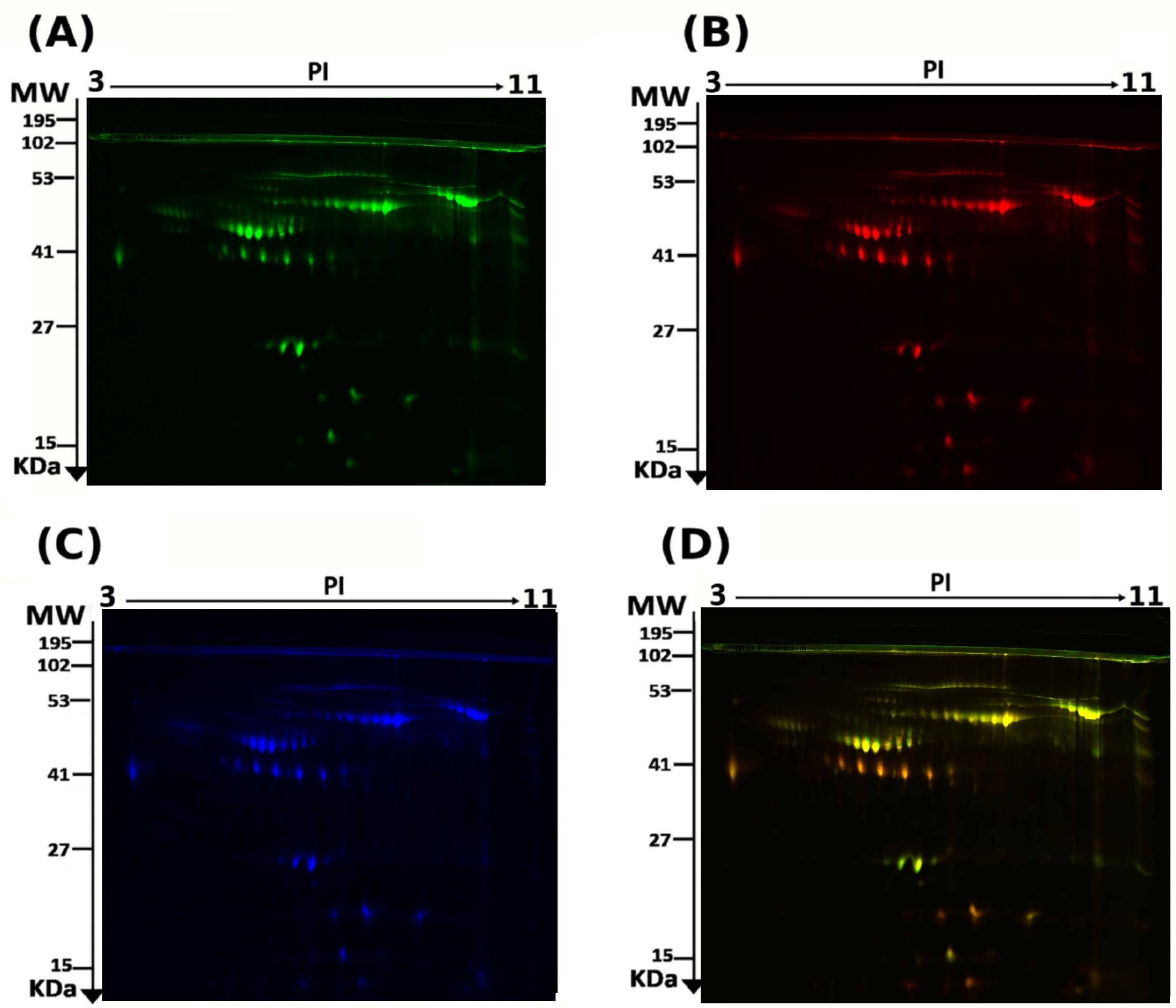

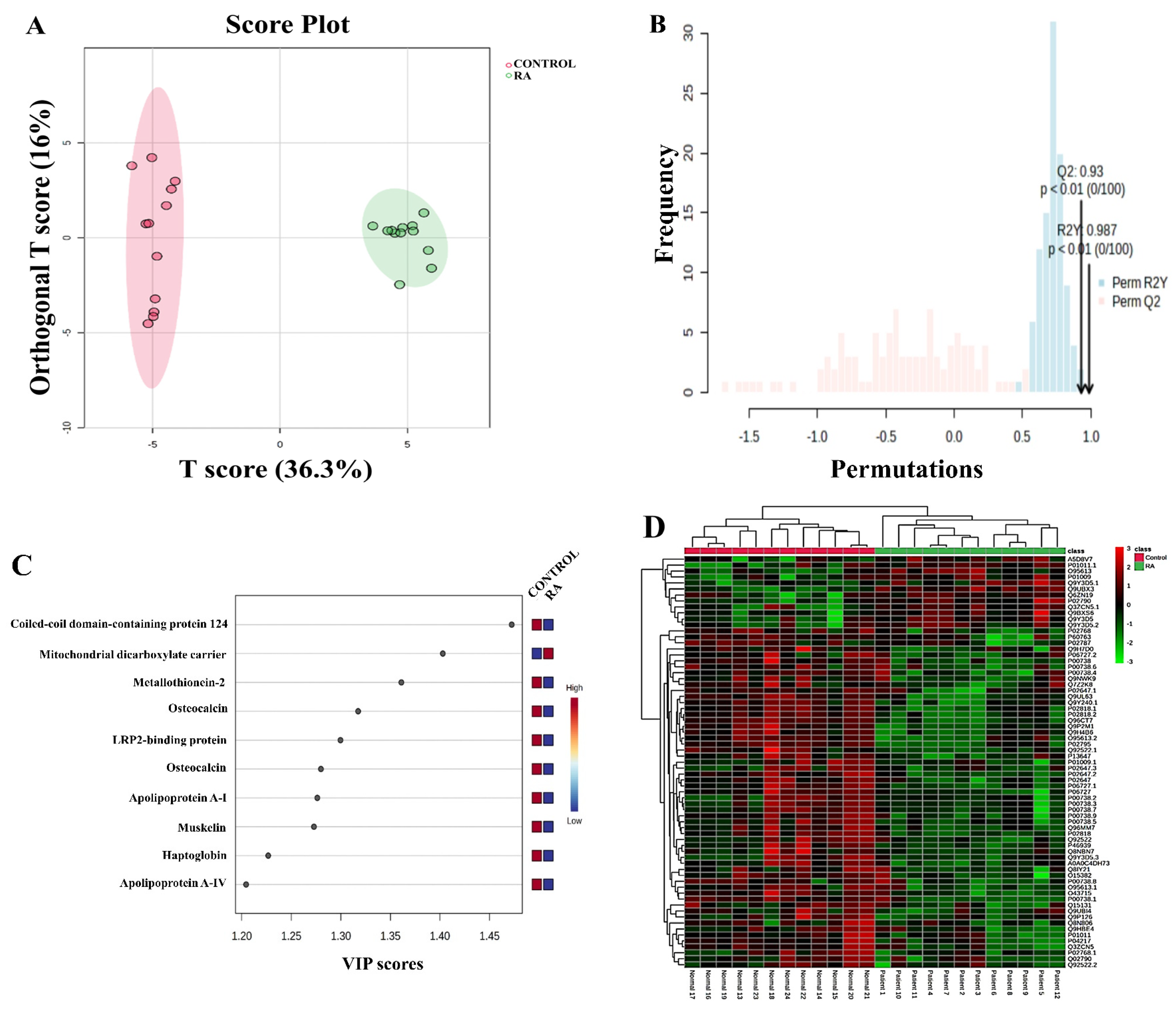
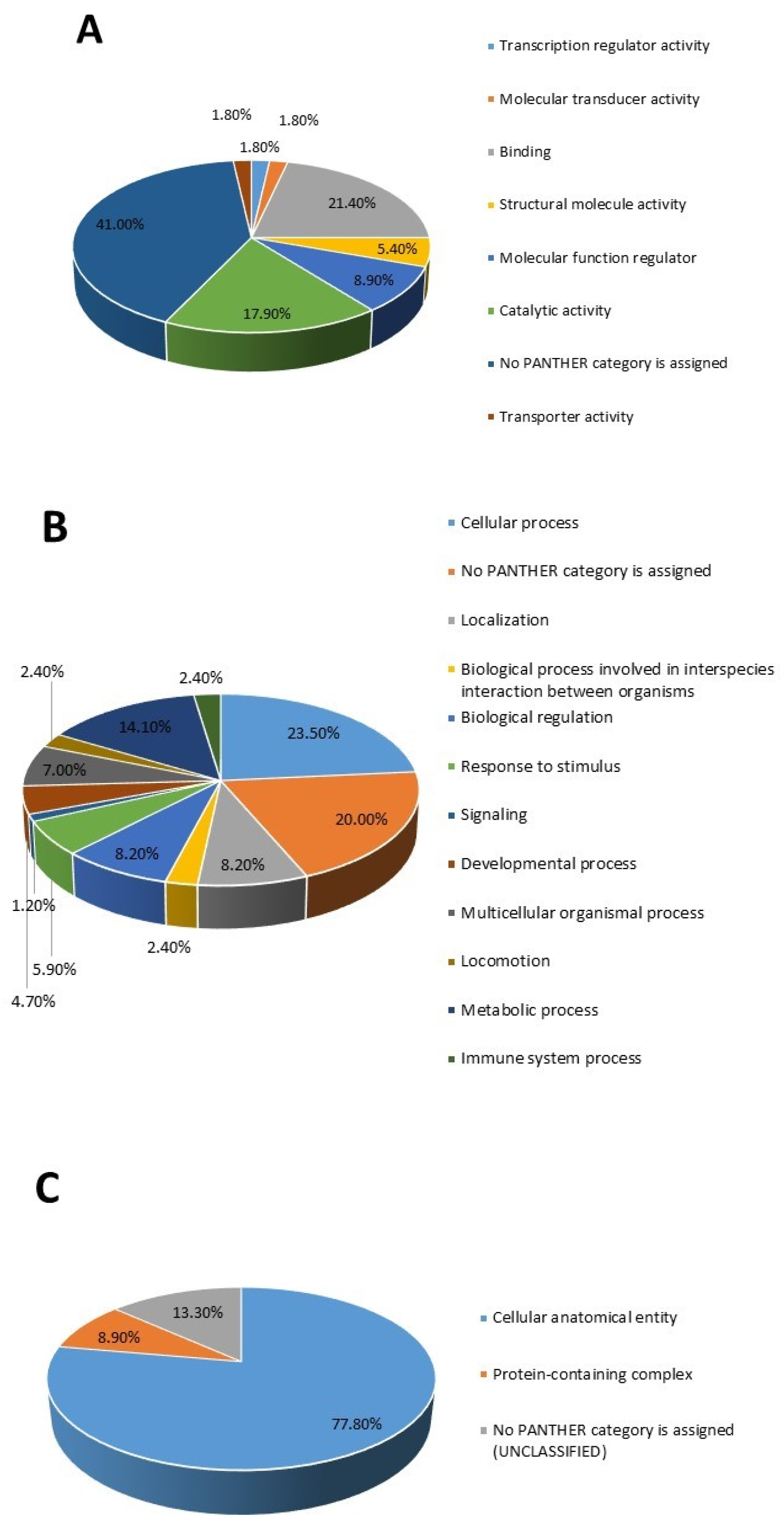
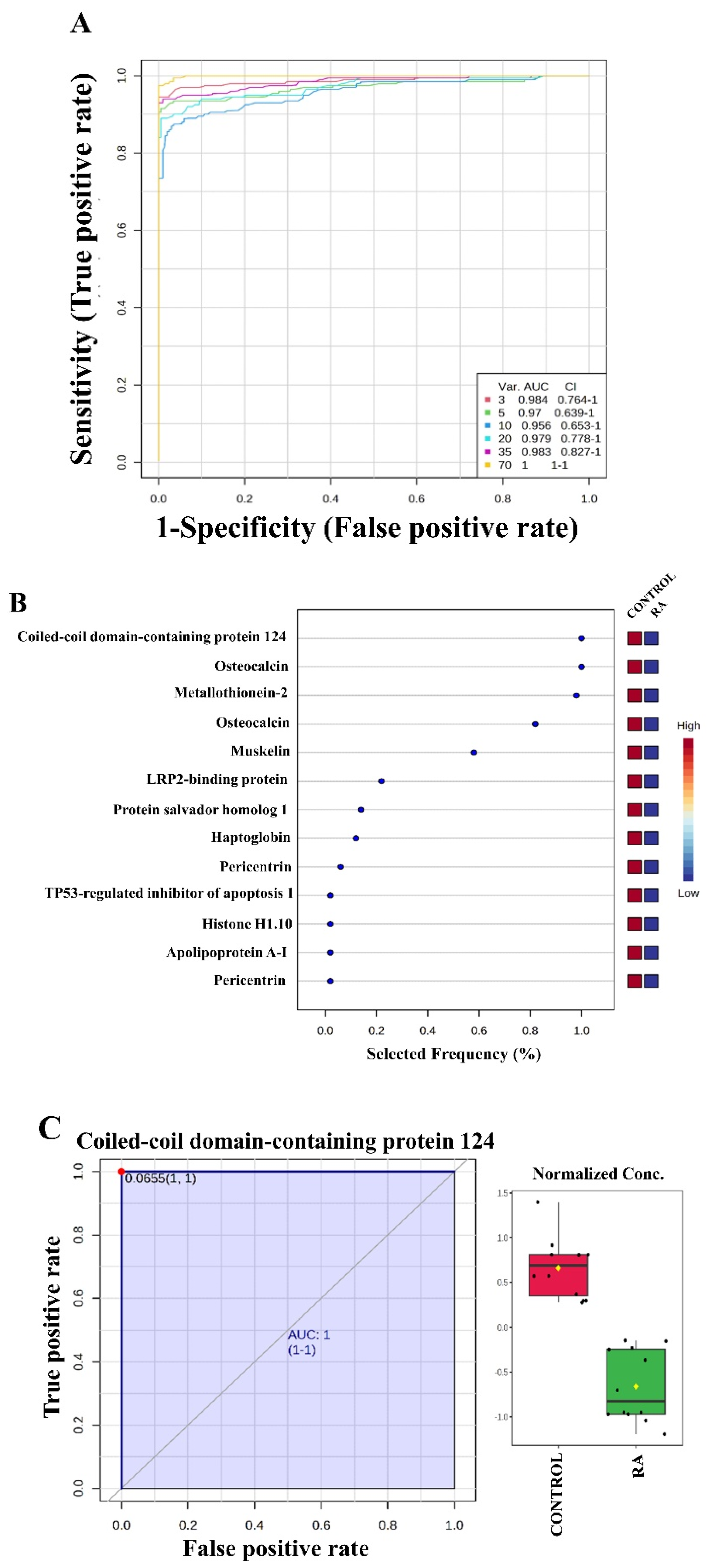
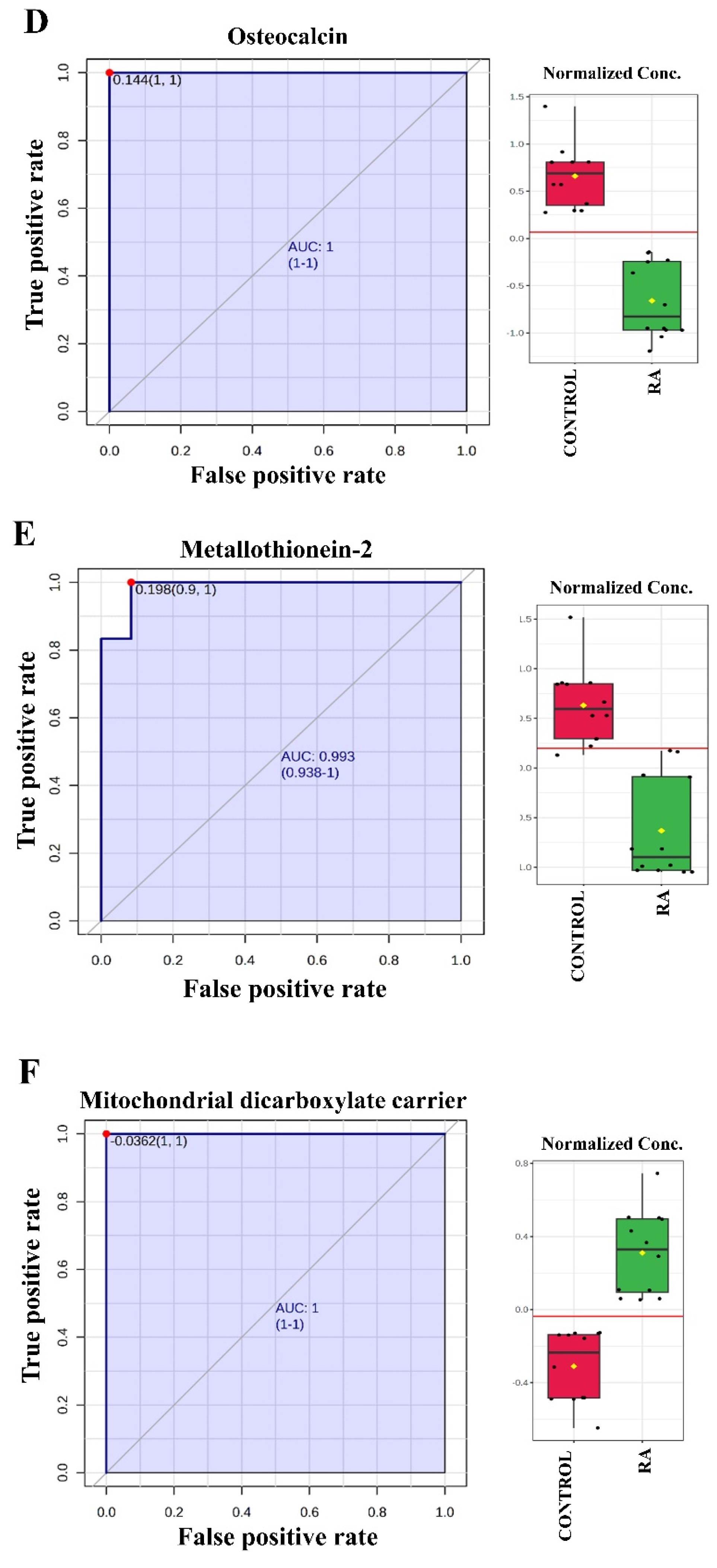
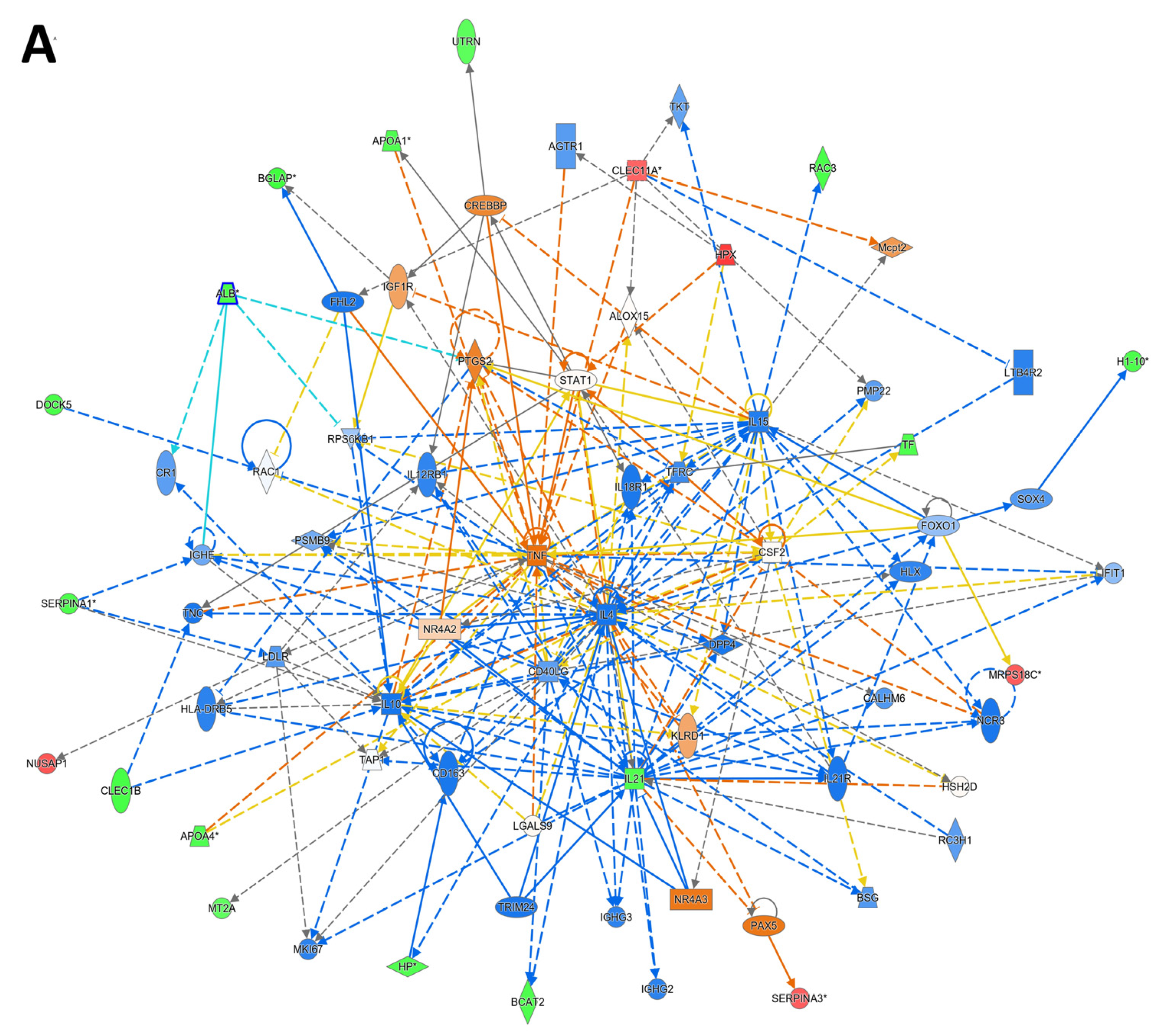

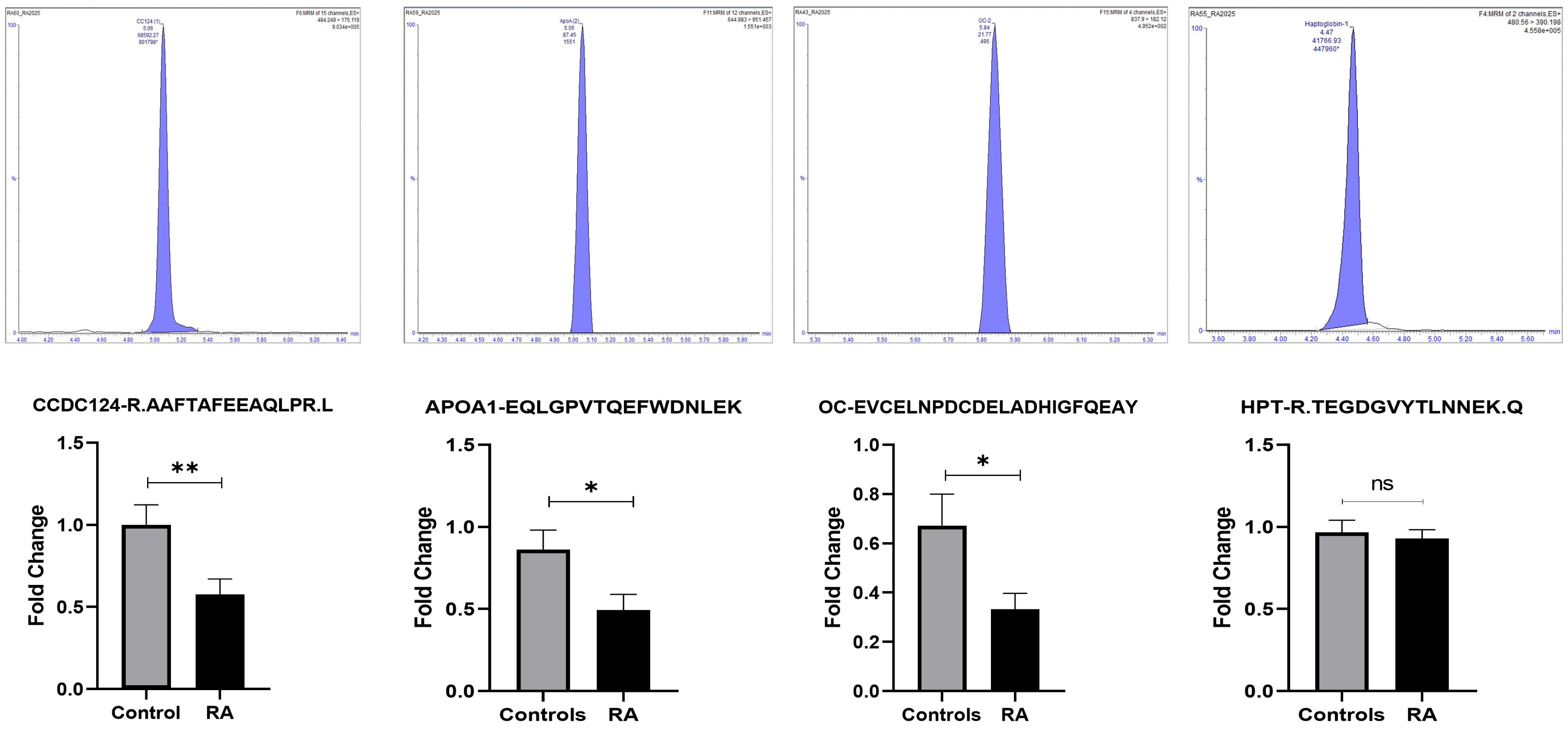
| Characteristics | Cases (Mean ± SD) (n = 12) | Controls (Mean ± SD) (n = 12) | p-Value | Cases (Mean ± SD) (n = 60) | Controls (Mean ± SD) (n = 63) | p-Value |
|---|---|---|---|---|---|---|
| Discovery Phase | Validation Phase | |||||
| Duration (yrs) | 14 ± 9 | 16 ± 7 | ||||
| Age | 46.8 ± 12.4 | 41.5 ± 6.2 | 0.19 | 49.8 ± 12.045 | 47.5 ± 13.86 | 0.32 |
| BMI (Kg/m2) | 24.2 ± 3.8 | 22.8 ± 4.2 | 0.40 | 29.1034 ± 7.2 | 29.9 ± 6.21 | 0.52 |
| HB (gm/L) | 126.8 ± 8.7 | 132.3 ± 14 | 0.26 | 127.2 ± 9.3 | 129.7 ± 9.6 | 0.44 |
| WBC 109/L | 6.5 ± 1.8 | 6.9 ± 2.7 | 0.60 | 6.8 ± 2.2 | 6.6 ± 2.4 | 0.59 |
| RBC (1012/L) | 4.4 ± 0.3 | 4.6 ± 0.6 | 0.15 | 4.8 ± 0.6 | 5.1 ± 1.3 | 0.07 |
| Lymphocyte (109/L) | 2.4 ± 0.8 | 2.5 ± 0.7 | 0.61 | 2.2 ± 0.7 | 2.4 ± 0.5 | 0.55 |
| Neutrophil (109/L) | 3.3 ± 1.3 | 3.6 ± 2.1 | 0.62 | 3.2 ± 1.3 | 3.1 ± 1.5 | 0.09 |
| ESR (mm/hr) | 48.5 ± 26.8 | 5.8 ± 2.1 | <0.001 * | 43.0 ± 23.8 | 5.6± 2.8 | <0.001 * |
| ALT (IU/L) | 20.5 ± 4.2 | 19.7 ± 9.3 | 0.7 | 18.99 ± 7.06 | 18.04 ± 9.01 | 0.08 |
| AST (IU/L) | 17.2 ± 6.7 | 17.4 ± 4.1 | 0.9 | 19.0 ± 7.0 | 16.7 ± 7.3 | 0.08 |
| Albumin (gm/L) | 38.4 ± 7.6 | 40.2 ± 3.3 | 0.3 | 39.9 ± 6.5 | 41.3 ± 4.9 | 0.22 |
| Glucose(mmol/L) | 4.9 ± 0.5 | 4.6 ± 0.4 | 0.6 | 5.48 ± 1.12 | 5.15 ± 0.85 | 0.07 |
| Chol (mmol/L) | 4.4 ± 1.2 | 4.3 ± 0.7 | 0.7 | 4.63 ± 0.78 | 4.77 ± 0.94 | 0.36 |
| HDL (mmol/L) | 1.4 ± 0.3 | 1.4 ± 0.4 | 0.5 | 1.47 ± 0.410 | 1.49 ± 0.37 | 0.316 |
| LDL (mmol/L) | 2.8 ± 1.0 | 2.4 ± 0.5 | 0.2 | 2.99 ± 0.81 | 2.70 ± 0.80 | 0.18 |
| Triglycerides (mmol/L) | 1.2 ± 1.2 | 1.1 ± 0.3 | 0.7 | 1.19 ± 0.74 | 1.27 ± 0.54 | 0.507 |
| HbA1c | 5.4 ± 0.5 | 5.2 ± 0.4 | 0.1 | 5.74 ± 0.54 | 5.71 ± 0.84 | 0.916 |
| CRP (mg/L) | 10.0 ± 7.8 | 2.4 ± 1.7 | <0.001 * | 9.70 ± 7.40 | 1.9 ± 3.4 | <0.001 * |
Disclaimer/Publisher’s Note: The statements, opinions and data contained in all publications are solely those of the individual author(s) and contributor(s) and not of MDPI and/or the editor(s). MDPI and/or the editor(s) disclaim responsibility for any injury to people or property resulting from any ideas, methods, instructions or products referred to in the content. |
© 2025 by the authors. Licensee MDPI, Basel, Switzerland. This article is an open access article distributed under the terms and conditions of the Creative Commons Attribution (CC BY) license (https://creativecommons.org/licenses/by/4.0/).
Share and Cite
Masood, A.; Benabdelkamel, H.; Alfadda, A.A.; Alarfaj, A.S.; Fallata, A.; Joy, S.S.; Al Mogren, M.; Rahman, A.M.A.; Siaj, M. Proteomic Profiling Reveals Novel Molecular Insights into Dysregulated Proteins in Established Cases of Rheumatoid Arthritis. Proteomes 2025, 13, 32. https://doi.org/10.3390/proteomes13030032
Masood A, Benabdelkamel H, Alfadda AA, Alarfaj AS, Fallata A, Joy SS, Al Mogren M, Rahman AMA, Siaj M. Proteomic Profiling Reveals Novel Molecular Insights into Dysregulated Proteins in Established Cases of Rheumatoid Arthritis. Proteomes. 2025; 13(3):32. https://doi.org/10.3390/proteomes13030032
Chicago/Turabian StyleMasood, Afshan, Hicham Benabdelkamel, Assim A. Alfadda, Abdurhman S. Alarfaj, Amina Fallata, Salini Scaria Joy, Maha Al Mogren, Anas M. Abdel Rahman, and Mohamed Siaj. 2025. "Proteomic Profiling Reveals Novel Molecular Insights into Dysregulated Proteins in Established Cases of Rheumatoid Arthritis" Proteomes 13, no. 3: 32. https://doi.org/10.3390/proteomes13030032
APA StyleMasood, A., Benabdelkamel, H., Alfadda, A. A., Alarfaj, A. S., Fallata, A., Joy, S. S., Al Mogren, M., Rahman, A. M. A., & Siaj, M. (2025). Proteomic Profiling Reveals Novel Molecular Insights into Dysregulated Proteins in Established Cases of Rheumatoid Arthritis. Proteomes, 13(3), 32. https://doi.org/10.3390/proteomes13030032










